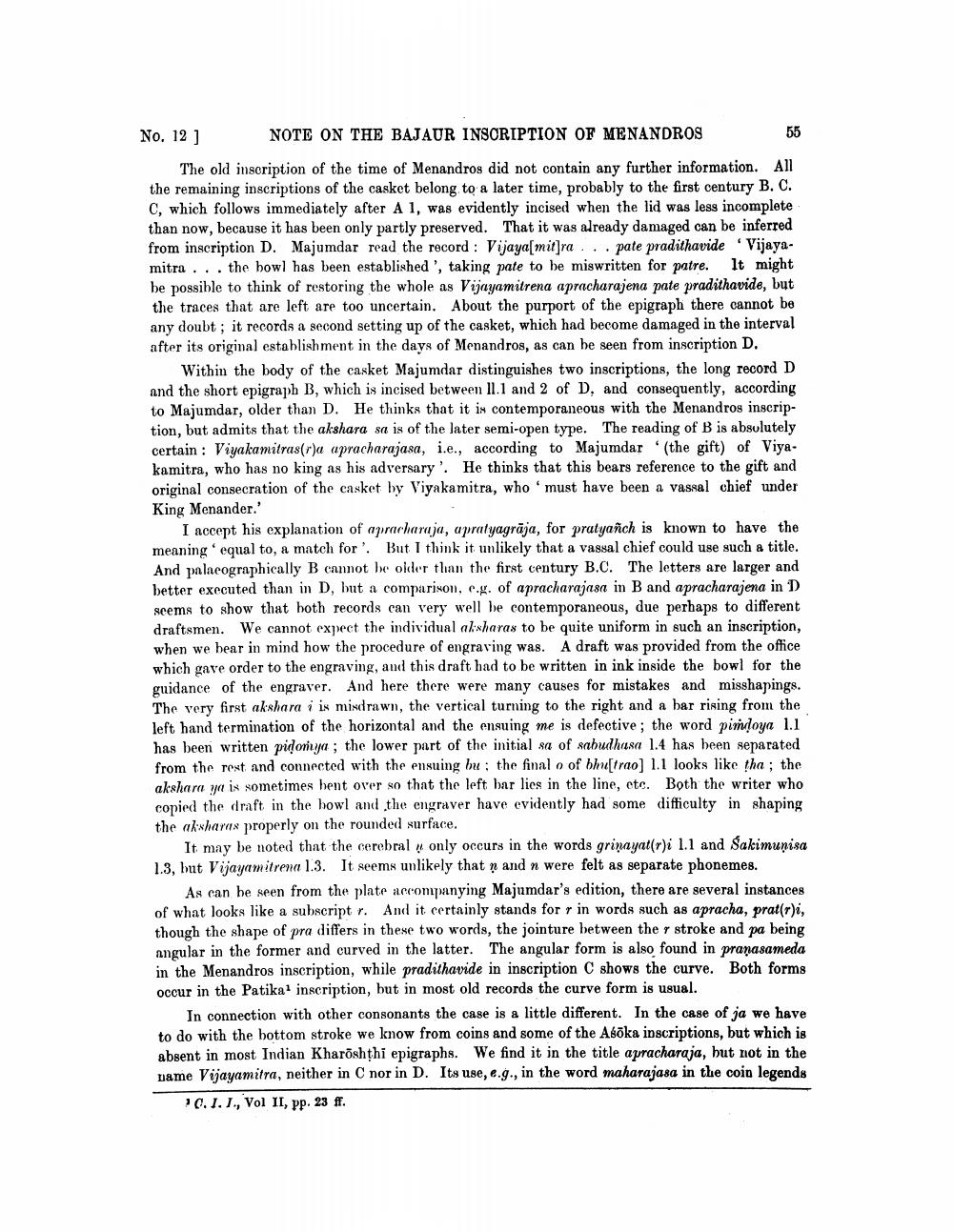________________
No. 12 ]
NOTE ON THE BAJAUR INSCRIPTION OF MENANDROS
The old inscription of the time of Menandros did not contain any further information. All the remaining inscriptions of the casket belong to a later time, probably to the first century B. C. C, which follows immediately after A 1, was evidently incised when the lid was less incomplete than now, because it has been only partly preserved. That it was already damaged can be inferred from inscription D. Majumdar read the record: Vijaya[mit]ra... pate pradithavide 'Vijayamitra... the bowl has been established', taking pate to be miswritten for patre. It might be possible to think of restoring the whole as Vijayamitrena apracharajena pate pradithavide, but the traces that are left are too uncertain. About the purport of the epigraph there cannot be any doubt; it records a second setting up of the casket, which had become damaged in the interval after its original establishment in the days of Menandros, as can be seen from inscription D.
55
Within the body of the casket Majumdar distinguishes two inscriptions, the long record D and the short epigraph B, which is incised between 11.1 and 2 of D, and consequently, according to Majumdar, older than D. He thinks that it is contemporaneous with the Menandros inscription, but admits that the akshara sa is of the later semi-open type. The reading of B is absolutely certain: Viyakamitras(r)a apracharajasa, i.e., according to Majumdar (the gift) of Viyakamitra, who has no king as his adversary. He thinks that this bears reference to the gift and original consecration of the casket by Viyakamitra, who must have been a vassal chief under King Menander.'
I accept his explanation of apracharaja, apratyagraja, for pratyañch is known to have the meaning equal to, a match for. But I think it unlikely that a vassal chief could use such a title. And palaeographically B cannot be older than the first century B.C. The letters are larger and better executed than in D, but a comparison, c.g. of apracharajasa in B and apracharajena in D seems to show that both records can very well be contemporaneous, due perhaps to different draftsmen. We cannot expect the individual aksharas to be quite uniform in such an inscription, when we bear in mind how the procedure of engraving was. A draft was provided from the office which gave order to the engraving, and this draft had to be written in ink inside the bowl for the guidance of the engraver. And here there were many causes for mistakes and misshapings. The very first akshara i is misdrawn, the vertical turning to the right and a bar rising from the left hand termination of the horizontal and the ensuing me is defective; the word pindoya 1.1 has been written pidomya; the lower part of the initial sa of sabudhasa 1.4 has been separated from the rest and connected with the ensuing bu; the final o of bhu[trao] 1.1 looks like tha; the akshara ya is sometimes bent over so that the left bar lies in the line, etc. Both the writer who copied the draft in the bowl and the engraver have evidently had some difficulty in shaping the aksharas properly on the rounded surface.
"
It may be noted that the cerebral only occurs in the words grinayat(r)i 1.1 and Sakimunisa 1.3, but Vijayamitrena 1.3. It seems unlikely that n and n were felt as separate phonemes.
As can be seen from the plate accompanying Majumdar's edition, there are several instances of what looks like a subscript r. And it certainly stands for r in words such as apracha, prat(r)i, though the shape of pra differs in these two words, the jointure between the r stroke and pa being angular in the former and curved in the latter. The angular form is also found in pranasameda in the Menandros inscription, while pradithavide in inscription C shows the curve. Both forms occur in the Patika1 inscription, but in most old records the curve form is usual.
In connection with other consonants the case is a little different. In the case of ja we have to do with the bottom stroke we know from coins and some of the Asoka inscriptions, but which is absent in most Indian Kharōshṭhi epigraphs. We find it in the title apracharaja, but not in the name Vijayamitra, neither in C nor in D. Its use, e.g., in the word maharajasa in the coin legends
C. I. I., Vol II, pp. 23 ff.




